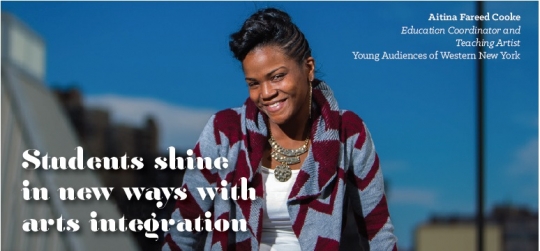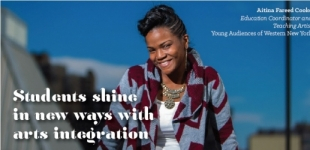
When you integrate arts into education, the students will surprise you.” That’s what Aitina Fareed Cooke found in her experience as a teaching artist in two very different places. Waterfront Elementary School, where Aitina worked with third and fourth graders, is in Buffalo, the second-largest city in the state of New York. The Harold O. Brumsted Elementary School, where she worked with first graders, is in Holland, a rural and residential community.
At first, Aitina wasn’t sure how the curriculum would work across the span of ages, grades, geographic areas, and abilities, which included one special education class at Waterfront. “I sat down with the teachers to talk about the curriculum and how it could benefit their classes. They told me what their students needed, so I got an idea of how I might need to implement elements differently. It was very much a coaching and collaborative experience working with the teachers.”
As for the students, “I was very impressed with how they were catching on in each grade. They were excited about drawing and, because I also integrated theater techniques into the class, they were eager to act out different scenes and even come up with their own scenarios,” she says.
The Arts for Learning unit Aitina presented was Graphic Story Adventures, which was designed to integrate visual arts with achieving such literary objectives as identifying story elements, visualization, author’s choices, predictions, sequencing, and summarization. With “My Father’s Dragon,” by Ruth Stiles Gannett, as the basis for the unit, students drew simple lines and shapes to indicate emotions felt by the characters in the story. These drawing techniques helped students to retain the information read and to come up with words to describe what was happening.
“The teachers were excited about the visual and theater aspects of the lessons because they allowed students to have a different voice in the classroom,” Aitina says. “Several teachers talked about how they saw students shine in ways they hadn’t seen before. Students who usually sat back and didn’t talk much in class were bursting out of their shells when it was time to act out the role of a dragon or gorilla. A whole new student emerged.”
The results were just as dramatic in the special education class, where Aitina included more hands-on activities and theater exercises. There was girl who didn’t speak much and, most of the time, had a teacher’s aide nearby. She would whisper her responses into the aide’s ear to write down. “By the third lesson, this student was talking to me directly, writing down her own responses, and wanting to do theater activities. The transformation was amazing to see,” Aitina says.
Another student had issues with expressing emotions, holding a lot of anger inside. Aitina discovered he liked to draw and, after a few lessons, she was able to reach him. “I kept him focused on drawing, and he was able to express the emotions of the different characters in this way. You could see him gain confidence because he was good at something in school, and he continued to draw and develop.”
Whether students come from rural or urban environments, from regular or special education classrooms, all can benefit from arts integration in the classroom. “Drawing gives students a different way to express themselves. And once they’ve drawn something, they often find it easier to put into words what they want to say. A lot of students are visual learners, and the arts show them there are different ways to learn,” Aitina says.
“The arts should not just be a sidebar to education or a fun activity in a 30-minute transitional period. It is imperative that arts become integrated with education and an integral part of the school day. Arts integration is important, and its value is apparent.”


